Stereoscopic 3D Monitor From iZ3D: Passive Glasses and Polarized Screens
by Derek Wilson on June 8, 2009 12:01 AM EST- Posted in
- GPUs
Earlier this year we had the opportunity to check out a new stereoscopic viewing system from NVIDIA called GeForce 3D Vision. Our feelings were a little mixed on the technology, as it isn't always seamless on top of a few other small issues. But, as we saw with Left 4 Dead, when the game doesn't do too many things that get in the way of the stereo effect, the experience can add a feeling of realism that it is simply impossible to achieve otherwise. And the other major drawback to NVIDIA's technology is that it only works with NVIDIA graphics cards.
At GDC we had the opportunity to check out the latest from iZ3D, a company that has been making stereoscopic drivers for quite a while now. Their drivers can enable stereo viewing on any PC through anaglyph (the red and blue tinted images we are all familiar with) in addition to working with various other technologies like stereo projectors. Most recently, iZ3D has introduced a stereoscopic viewing system that makes use of an actively polarized monitor and passive glasses in order to bring simple and easy to use stereoscopic viewing to the masses without the color distortion associated with anaglyph. The 22" monitor package they sent us to test comes in at $400.
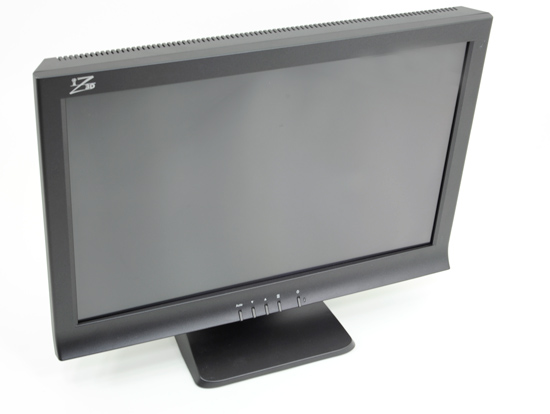
This is different than NVIDIA's technology which makes use of active glasses for viewing a regular CRT monitor or LCD panel (although the monitor needs to be capable of 120Hz for it to look right). Additionally, iZ3D's solution will work with any video card that can do 3D graphics (including not only ATI, but Intel and S3). This broad range of compatibility gives them a clear advantage in terms of the potential market and end user options.

The fact that this solution includes passive glasses that don't require any line of sight with a transmitter and never need to be charged along with the ability to use ATI graphics cards made us really want to like this solution. But there are just a few drawbacks that make it really hard for us to like iZ3D as much as we want to. Both approaches require that games do a better job of accommodating stereoscopic viewing, but even disregarding resulting anomalies there are some issues we have that really get in the way. Before we get into that, let's talk about what iZ3D is actually doing to achieve their stereo effect.
Technology
While NVIDIA's technology requires a fast monitor, it doesn't require a truly "special" monitor. The 120Hz LCD panels aren't special beyond the fact that that they can actually display a higher refresh rate than 60Hz panels. On the other hand iZ3D makes use of a whole other technology to build its monitors in a way to display stereo images. The iZ3D monitor actually has two overlaid LCD panels. There is a back screen and a front screen, with the back screen controlling the color and brightness of the pixels and the front screen controlling the polarization of the light coming through.

Polarization has to do with the way the light moves as a wave. Polarized light all moves in waves rolling in the same orientation. Filters can be used to either allow polarized light to pass through or to block it out. These filters allow light to pass through if they are lined up, but completely block light that is at a 90 degree angle to the direction of the filter. At in between angles, a proportional amount of light is filtered out.
The iZ3D monitor has the capability of polarizing light at any angle, and the glasses they use have the right lens set at 45 degrees and the left lens set at 135 degrees. It is up to the iZ3D driver to display the rendered image for the right eye and the rendered image for the left eye, and then use their polarizing LCD panel to determine how much of each pixel from the back screen either eye is supposed to see. If a pixel should be visible to the right eye, the front panel polarizes it to 45 degrees, if it should be visible to the left eye, 135 degrees. If it should be visible to both equally, the light is polarized to 90 degrees. This happens on the sub-pixel level for each of red, green and blue.

This puts all the technology into the driver and the monitor and leaves the glasses free of anything like batteries or receivers. Simple clip on filters can be added over top of existing eye wear very easily. Removing a maximum of the complexity from the gamers face is definitely a plus for stereoscopic viewing.
What's the Difference Between this and GeForce 3D Vision?
The key difference with GeForce 3D Vision is that active glasses flash between translucent and black every 120th of a second. For one 120th of a second, the right lens is clear and the left is black, and for the next 120th of a second, the right lens is black and the left is clear. This flashing, while really fast and mostly not noticeable, can bother some people (though this is nowhere near the problem it was for slower 60Hz glasses) and significantly reduces the brightness of the display. This also requires NVIDIA's glasses to have a battery and be highly synchronized with the display via a wireless transmitter. NVIDIA has made this very compact, but it is still tough to fit over regular glasses for those who need this. The iZ3D glasses do not cut out as much light, and are much more user friendly.
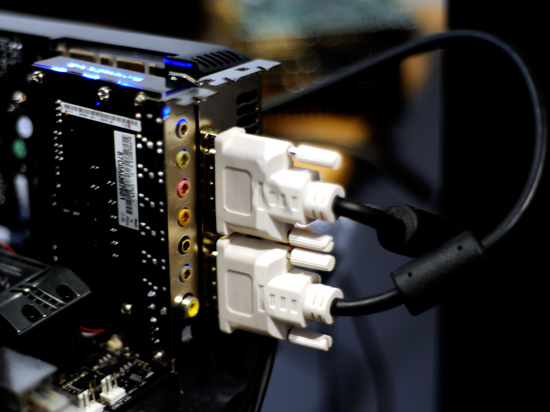
With iZ3D's solution, two display outputs must be connected to the monitor, but 3D Vision only requires one. This isn't such a big deal in today's market with the vast majority of cards having two DVI-I outputs.

The bottom line, however, is that NVIDIA's approach draws exactly what should be shown to the left eye on one frame and then exactly what should be shown to the right eye on the next. With iZ3D, polarization is used to selectively adapt the brightness of each color for each pixel in order to build a close approximation of what the left eye should see through its 135 degree lens and what the right eye should see in its 45 degree lens. With iZ3D, the images are not different frame to frame if the camera is static, while NVIDIA's solution will swap back and forth between perspectives constantly.
Compatibility and Ease of Use
Both 3D Vision and iZ3D solutions can run on the majority of DX games out there, and iZ3D supports some OpenGL games (though it did not like working with The Chronicles of Riddick: Assault on Dark Athena). The advantage of iZ3D is the fact that it can run on AMD hardware and NVIDIA hardware (as well as Intel and S3 if you want). This blend of hardware and software compatibility make it more attractive than NVIDIA's offering which only runs on NVIDIA graphics cards, despite the fact that this isn't exactly necessary from a technological stand point. But It is NVIDIA's goal to sell more NVIDIA graphics cards by using 3D Vision, not to sell more 3D Vision packages.
So while general compatibility is a win for iZ3D, there is quite a downside. NVIDIA has spent a good deal of time profiling applications and has built in settings for convergence and separation in games and has done a great job of making the experience pretty well plug and play. They do enable users to tweak the settings manually in the driver or with hot keys, which is also useful even though you need to dig to find the option.
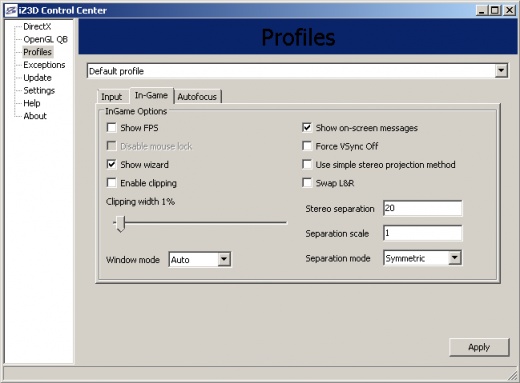
The experience with iZ3D is not as pleasant. Their latest beta driver does try to make things easier with a wizard that is overlaid on the screen to help determine how to set convergence and separation, but even this is clunky and not very user friendly. The wizard takes you through ten steps of looking and adjusting various aspects of the image, and for a novice to step in and pick this up without getting frustrated is asking way too much. For the enthusiast, iZ3D does do a good job of explaining how to tweak the settings to get a good stereo experience, which NVIDIA definitely leaves out.

Image Quality
Image quality is really important, and despite its drawbacks, NVIDIA's 3D Vision clearly has the image quality advantage.
The look of iZ3D's technology, when it does exactly what you would expect, can be better than the NVIDIA experience. There is a more solid feeling and less eye strain from the lack of any flicker at all. Being forced to manually tweak the image tends to deliver a better result as well, as the scroll bar separation adjustment only offers one aspect of configuration. The brightness is better as well, and when there can be less color distortion there is less color distortion.
Let me clarify that last bit. The downfall of the iZ3D solution is in the fact that it is not capable of completely eliminating from visibility what one eye should not see in every case. In low contrast situations where images are made of similar colors, the iZ3D solution is superior in effect (Call of Duty and FarCry 2 are good examples). Unfortunately, games with high contrast and varied tonality don't translate as well. This is because it is not possible to display the entire range of colors to both eyes at the same time using iZ3D's polarization technology. The result is bleed over between the images our eyes are supposed to see resulting in some difficult-to-deal-with ghosting.
At best, this ghosting just sort of adds a glow or blur around objects, but at worst it can make it impossible to focus on the stereo image. Imagine having a single object and instead of seeing two different images (one with each eye) you saw four different images (both the left and right view in both eyes). Even if you are able to force your eyes to focus at the right distance, you would still have three different images: the left image seen in the right eye, the right image seen in the left eye, and the composite left and right image at the correct distance. This is utterly unacceptable.
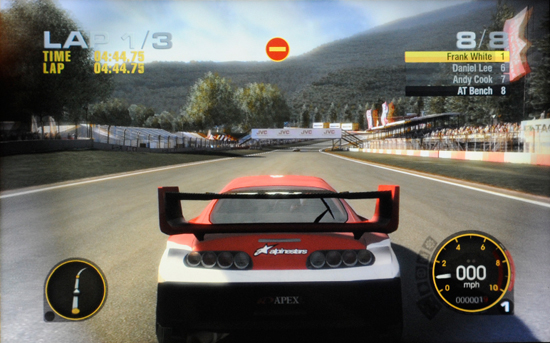
To illustrate, we took a picture of a scene in GRID through the left lens (which tended to have worse ghosting). What should be seen is only a left eye image, but a ghost of the right eye image is clearly visible on the flags. This is nothing one eye should ever see.
Final Words
We really wanted to love this solution. NVIDIA's 3D Vision gets close, but is still lacking and needs better support from developers and is not available to owners of other graphics hardware. But despite the fact that iZ3D delivers on hardware compatibility and offers passive glasses that are much more user friendly, the fact that each game requires manual tweaking combined with the image quality issues really disappointed us. For an NVIDIA owner, GeForce 3D Vision adds more value, and the iZ3D monitor really isn't something we believe would add as much value to an AMD set up as 3D Vision adds to NVIDIA hardware (which still isn't a lot without much better developer and software support).
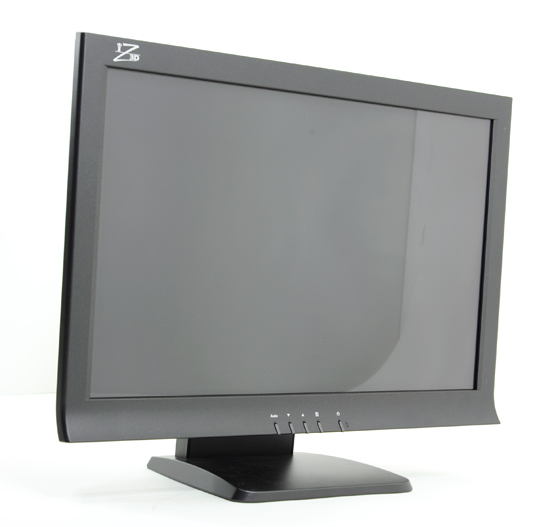
Note that our photobox is clearly visible in the reflection
The last issue we'd like to mention is the fact that the monitor is hugely reflective. I'm quite used to the glossy screen on Apple's MacBook; the reflectivity of the iZ3D monitor goes beyond what is reasonable. It can be distracting seeing your own reflection while trying to focus on a 3D object with each eye's image bleeding over into the other.
What might work better (excepting the reflectivity of course), is for iZ3D to come out with a 120Hz version that switches between 45 degrees and 135 degrees polarization every frame and displays the left and right images in alternating frames. This would mean essentially doing the same thing NVIDIA does but with polarization rather than blacking out the actual lens itself. The active switching could happen right in the monitor rather than on your face so we could keep the passive glasses. This might not be the best solution either, but the idea might combine the best of the available solutions out there.
But the bottom line is that we just can't recommend this product. We really want pervasive, great looking stereoscopic gaming, but it seems we're going to have to wait a little while longer as no one is offering a holy grail solution... yet.










31 Comments
View All Comments
atlmann10 - Monday, June 8, 2009 - link
I want 3D PronI want 3D Pron
I want 3D Pron
I want 3D Pron
I want 3D Pron